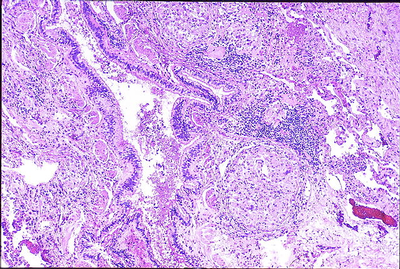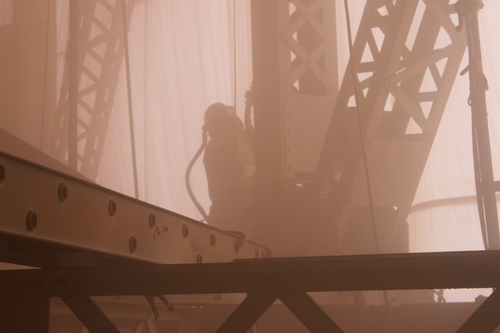TUESDAY, APRIL 3, 2018
New data released by a blasting-abrasive industry trade group appears to show higher levels of beryllium than previously recorded in a number of abrasive media, though manufacturers of those products have questioned the methods and motives of the group that published the new study.
The Abrasive Blasting Manufacturers Alliance released the new data March 22, based on an analysis of several garnet, staurolite, glass and aluminum oxide abrasive products carried out by California-based scientific consulting firm Exponent.

 |
| Images courtesy of Technology Publishing Co. unless noted |
|
The new study released by the Abrasive Blasting Manufacturers Alliance reports beryllium levels higher than previously recorded in a number of garnet and aluminum oxide abrasives, but manufacturers of those products say the numbers do not match the data they have on their media. |
The data follows up an earlier release of a study of only crushed-glass abrasives, carried out by the same firm. The ABMA has been active in arguing that the Occupational Safety and Health Administration’s new beryllium rule will be an undue burden on blasting operations using any abrasive, and holds that no abrasive media can be considered to be beryllium-free.
The study indicates beryllium levels between 0.2 and 1.6 milligrams per kilogram in five different garnet abrasives, 0.4 mg/kg in one glass abrasive sample, 5.16 mg/kg in an aluminum oxide sample, and 13.6 mg/kg in a staurolite abrasive sample. (Milligrams per kilogram and micrograms per gram are both measurements that are equivalent to parts per million.)
The previous study of crushed-glass abrasives indicated beryllium levels between 0.27 and 0.76 mg/kg in 18 samples.
The new information comes as federal workplace-safety researchers say they won't perform further work to clarify the risk of beryllium exposure in abrasive blasting operations, leaving abrasive manufacturers to supply information on their products themselves.
Suppliers React
Barton International, the manufacturer of one of the garnet abrasives included in the study, responded with a statement to PaintSquare Daily News reading in part: “The test data presented in the ABMA report does not match the results obtained by an independent accredited lab that recently tested our products. […] The test data demonstrates that beryllium levels in Barton’s garnet are non-detectable; results were below EPA Method 6010C/3050B detection capabilities.”
A letter Barton sent to customers concerned about beryllium content says any beryllium content in the company’s garnet products is below the limit of detection, which the firm says is 0.0004 percent, or 4 ppm. (The ABMA study puts the Barton products' beryllium level above zero, but below 4 ppm.)
Pete Mitchell, vice president of sales and marketing for GMA Garnet Group, another company whose products were included in the study, said his firm tests “every product from every plant on a regularly scheduled basis and our numbers are so much lower than what Exponent is reporting, we are questioning their results.”
Chemours, which makes the Starblast staurolite abrasive named in the study, took specific issue with the arsenic level listed for its product, which is nearly eight times the concentration the company says the abrasive typically tests at.
"Contained in a March 22, 2018 email to members was the ABMA’s Comprehensive Blasting Materials Content Study, which reported arsenic levels found in StarBlast abrasives of 158 ppm," the company said in a statement. "The amount of arsenic typically found in independent lab testing of the Chemours abrasives is less than 20 ppm.
"The company is questioning the accuracy of the data and whether the ABMA calculations considered previously identified testing interferences associated with EPA Method 6020A, which requires an adjustment calculation to the final results."
Chemours says it has requested the ABMA confirm the test method used and issue an amended report on the findings.
Beryllium Rule Debate
The ABMA in the past argued against the promulgation and enforcement of the Occupational Safety and Health Administration’s new beryllium rule, set to go into partial effect next month. The organization has fought characterizations that slag abrasives are the only abrasive products likely to be affected by the measures put into place in the rule, which drops the permissible exposure level from 2.0 to 0.2 micrograms per cubic meter of air (as a time-weighted average over eight hours) and establishes an action level of 0.1 micrograms per cubic meter.
Companies identified in ABMA materials as members of the group include Abrasives Inc., Canam Minerals Inc., Ensio Resources Inc., Harsco Minerals, Mobile Abrasives Inc., MineralTech Gulf Coast Abrasives LLC and U.S. Minerals Inc.
About the Rule
Beryllium is a component of coal, certain rock materials, volcanic dust and soil that is used in several industrial applications. Breathing air containing beryllium can deposit beryllium particles in the lungs, presenting immune-system and respiratory risks. Beryllium is a known human carcinogen and can cause chronic lung disease.
 |
| Yale Rosen, CC BY-SA 2.0, via Wikimedia Commons |
|
Beryllium is a known human carcinogen and can cause chronic lung disease (shown here in medical imaging). |
The new beryllium rule was published after years in development, authored primarily by OSHA, the United Steelworkers union and Materion Brush, the country’s largest supplier of beryllium. In general industry, beryllium is used as an aerospace material, in nuclear reactors and in some medical applications, as well as for other specialized uses.
For the construction and maritime industries, the rule applies when materials being used contain greater than 0.1 percent beryllium by weight—the equivalent of 1,000 ppm, or 1,000 mg/kg. Employers using materials with a lesser beryllium content are exempt, “if the employer has objective data demonstrating that employee exposure to beryllium will remain below the action level of 0.1 μg/m3, as an eight-hour time weighted average, under any foreseeable conditions.”
OSHA on Trace Amounts
Abrasive blasting is one instance in which OSHA indicates there is a possibility that beryllium exposure could rise above the action level even when beryllium levels in the material are much lower than 1,000 ppm, because of the fine dust created during the blasting process.
OSHA’s guidance on materials containing “trace amounts” of beryllium, according to the “frequently asked question” portion of the agency’s beryllium rule website, involves extrapolating the beryllium content of the abrasive in relation to total dust (“particulates not otherwise classified”) generated on the job.
“For example, for coal slag that contains 2 ppm (0.0002 %) beryllium by weight, the final action level of beryllium of 0.1 μg/m3 would be exceeded only when total dust concentrations exceed 50 mg/m3, a level that is over 3 times higher than the current 29 CFR 1910.1000 (Table Z-1-Limits for Air Contaminants) PEL of 15 mg/m3 for PNOC (particles not otherwise classified). In this particular situation, if the employer has objective data that shows that exposures are below the PEL for PNOCs, or even up to 3 times the PEL for PNOCs, then this material would be exempt from the beryllium standards.”
Elemental vs. Airborne Testing
Mitchell, of GMA Garnet, argues that in using an elemental analysis, the ABMA is distracting from the crux of the new beryllium rule: airborne beryllium levels. There is a relative dearth of publicly available data on airborne levels of beryllium and other metals in blasting operations; the ABMA’s Michael Bova pointed out to PSDN that a 1998 study conducted by KTA-Tator Inc. for the National Institute for Occupational Safety and Health showed airborne beryllium levels at or above the new action level for at least one sample of every type of media tested.
 |
|
The methodology of controlled field studies of air quality in abrasive blasting operations has been called into question. |
Bova also pointed out a concern echoed by both sides of the debate: The methodology of controlled field studies of air quality in abrasive blasting operations has been called into question, including in a 2013 article for the Journal of Occupational and Environmental Hygiene, in which authors from NIOSH concluded that “current [personal breathing zone] air sampling techniques are not effective in assessing employee exposures during abrasive blasting” and “identification of alternative methods for assessing worker exposure during abrasive blasting operations is still needed.”
NIOSH has reportedly declined to perform further objective research on bulk and airborne beryllium content in abrasives despite the controversy over the new rule and questions regarding the airborne testing methodology of the 1998 study and others.
Study Differences
Adding to the confusion over the issue, the 1998 study’s bulk elemental analysis—among the few pieces of research available by which to benchmark the new ABMA study numbers—in many cases doesn’t jibe with the Exponent study results.
The KTA-Tator study’s analysis looked at seven garnet samples, with beryllium content ranging from non-detectable to 0.07 ppm, while the Exponent study looked at five garnet samples and found a range between 0.23 and 1.66 ppm. The KTA-Tator study examined two staurolite samples and found beryllium at concentrations of up to 0.01 ppm; the Exponent study’s staurolite sample was found to have beryllium at a concentration of 13.6 ppm.
The ABMA's Mark Mummert says the discrpancy likely has to do with testing methods. "Exponent used a laboratory that is experienced with bulk testing under Proposition 65 in California and that lab used methods to ensure complete dissolution of the samples that we sent them," Mummert told PSDN. "We don’t have comparable information on what methods were used by KTA, but we suspect that their results may be biased low because complete dissolution was not achieved."
There is very little other literature to go by in the beryllium debate. A 2001 study in Toxicological Sciences compared numerous abrasives but reported that beryllium was not detected in any of the samples. A 2005 study prepared for the Advanced Technology Institute, in South Carolina, did not include beryllium content in its elemental breakdown of the abrasives studied, and did not included crushed-glass abrasives.
The ABMA’s studies have not examined slag abrasives in comparison with the garnet, glass, staurolite and aluminum oxide abrasives studied; Bova says the point of the studies has not been to argue that slags do not contain beryllium, but to show that all other abrasive media also contain the element despite some manufacturers "claiming that their abrasives are beryllium-free."
The 1998 KTA-Tator study found beryllium content between 0.28 and 6.3 ppm in seven coal slag samples, and 0.04 and 1.4 in four copper slag samples. Many coal slag abrasives list beryllium at a concentration between 2 and 10 parts per million on their safety data sheets; most garnet, staurolite and crushed-glass abrasive manufacturers do not list beryllium content on their safety data sheets.
Editor's note: This article was updated April 3 to reflect an official statement from Chemours, which was unavailable at the time of first publication.
Tagged categories: Abrasive blasting; Abrasives; Beryllium; Health & Safety; Health and safety; NIOSH; OSHA; Regulations